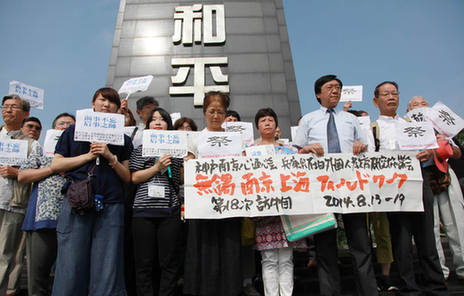By staff reporter AN XINZHU
Memorialize the Victims of the Nanjing Massacre
The Nanjing Massacre refers to the 40-day slaughter committed by the Japanese army in the early stages of their invasion of China, which cruelly claimed the lives of more than 300,000 civilians and captured soldiers. One third of the city was razed and property losses were beyond count.
Some believe that the Nanjing Massacre, along with Auschwitz Concentration Camp and bombing of Hiroshima (the first use of atomic weapons in combat) were the three greatest tragedies of WWII. Some refer to the massacre as the “Asian Auschwitz.”
 |
|
Peace-loving people rallied in the Memorial Hall of the Victims of the Nanjing Massacre by Japanese Invaders on August 15, 2014. |
A City’s Memory
Eighty-five-year-old Xia Shuqin is one of the massacre’s survivors. On December 13, 1937, Japanese troops invaded Nanjing. Seven members of Xia’s family were killed on that day; eight year old Xia only survived because she fainted after being stabbed three times. Her family’s tragedy was filmed by John G. Magee, an American priest and later chairman of the International Commission of the Red Cross in Nanjing. Over the following days one person was killed every 12 seconds. It was a nightmare for everyone in Nanjing.
On August 15, 1945, the Japanese Emperor broadcast the Imperial Rescript on the Termination of the War, marking Japan’s unconditional surrender and China’s victory in the war of resistance. After the war, the International Military Tribunal for the Far East and China’s Nanjing War Crimes Tribunal, one of the Allied War Crimes Courts, tried the Nanjing Massacre as a special case. China’s Nanjing War Crimes Tribunal adjudged that the Japanese army had slaughtered more than 190,000 people on 28 separate occasions while murdering over 150,000 people in 858 episodic killings. The death toll exceeded 300,000.
However, the Japanese side continues to obfuscate history. In 1982, Japan’s Ministry of Education revised textbooks to replace the term “invasion” with “advance” to describe the war in China, earning the ire of the Nanjing public. On December 13, 1983, a monument was erected in Jiangdongmen, the site of mass executions and burials. In 1985, Nanjing opened the Memorial Hall of the Victims of the Nanjing Massacre by Japanese Invaders.
Zhu Chengshan has curated the memorial hall for 22 years. At that time, the memorial hall’s less than 100 exhibits and historical records were mainly limited to photographs. Zhu mobilized domestic and overseas support to collect more massacre-related objects. At the same time, construction began of a memorial wall engraved with the victims’ names. Zhu also launched oral surveys of seniors above 70 years old to collect survivors’ testimony.
While Zhu endeavors to save the city’s memory, Japanese right wingers continue to deny the facts of the Nanjing Massacre. Xia Shuqin decided to stand up in defense of the truth. At the invitation of a Japanese non-governmental organization, Xia Shuqin and Zhu Chengshan visited Japan in August 1994 to expose the truth of the slaughter. In Hiroshima and Nagasaki, they attended memorials for the victims of atomic bombs in 1945. The largest rally attracted over 100,000 people. Participants included core leaders of the state and major parties. Japan’s Prime Minister also delivered a short speech.
“I had mixed feelings about it,” Zhu said. “The Japanese were paying their respects to war victims. But in China, we had never held any form of ceremony to mark the anniversary of the massacre.” After returning from Japan, Zhu Chengshan proposed memorial events for the victims of the massacre in Nanjing.
On December 13, 1994, the first-ever commemorative event was held in Nanjing. Representatives from all walks of life attended the ceremony in the memorial hall and released peace doves. An air-raid siren wailed across the city.
In the following years, commemorations grew to include peace rallies, wreath-laying, tolling of bells and the presentation of a peace declaration.
